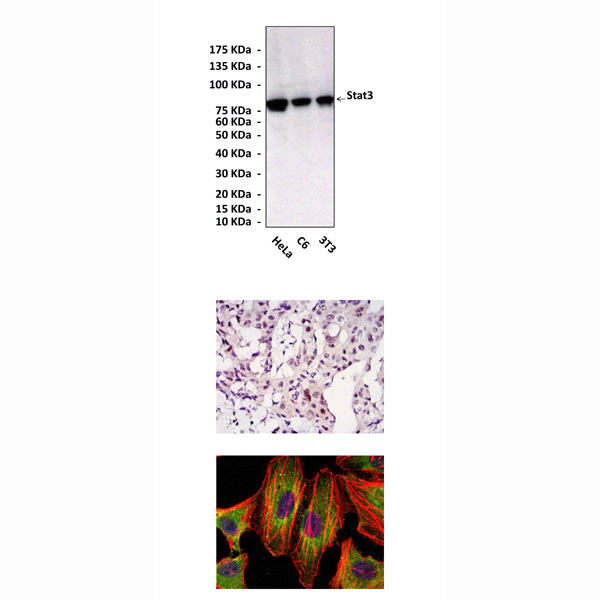Anti-Stat3: Monoclonal Signal Transducers & Activators of Transcription 3 Antibody |
 |
BACKGROUND Signal transducers and activators of transcription (STATs) comprise a unique family of transcription factors, which transmit the interactions of cytokines, hormones and growth factors with their cell surface receptors into transcriptional programs. The mechanism of STAT activation has been well-established and comprises tyrosine phosphorylation, dimerization, nuclear translocation, binding to specific DNA response elements, recruitment of co-activators or co-repressors, and transcriptional induction or repression of target genes.1 STAT3, a member of STAT family, has been known as a mediator for gene expression induced by many important cytokines and growth factors.2 It plays diversified roles in cell growth, differentiation, apoptosis, oncogenesis, and stem cell renewal. Stat3 is constitutively activated in many human cancers, where it functions as a critical mediator of oncogenic signaling.3 Thus, Stat3 is also a target for cancer therapy.
REFERENCES
1. Desrivieres, S. et al., J Mammary Gland Biol Neoplasia. 11:75, 2006
2. Fu, XY, Cell Res. 16:214, 2006.
3. Jing, N. & Tweardy, DJ., Anticancer Drugs. 16:601, 2005.
2. Fu, XY, Cell Res. 16:214, 2006.
3. Jing, N. & Tweardy, DJ., Anticancer Drugs. 16:601, 2005.
Products are for research use only. They are not intended for human, animal, or diagnostic applications.
Параметры
Cat.No.: | CB10245 |
Antigen: | recombinant human Stat3 protein |
Isotype: | Mouse Monoclonal IgG1 |
Species & predicted species cross- reactivity ( ): | Human, Mouse, rat |
Applications & Suggested starting dilutions:* | WB 1:1000 IP n/d IHC (Paraffin) n/d ICC n/d FACS n/d |
Predicted Molecular Weight of protein: | 79 & 86 kDa |
Specificity/Sensitivity: | Reacts with human, mouse, & rat Stat3 in Western Blot applications. |
Storage: | Store at 4° for frequent use; at -20° for at least one year |
*Optimal working dilutions must be determined by end user.
Документы
Информация представлена исключительно в ознакомительных целях и ни при каких условиях не является публичной офертой








